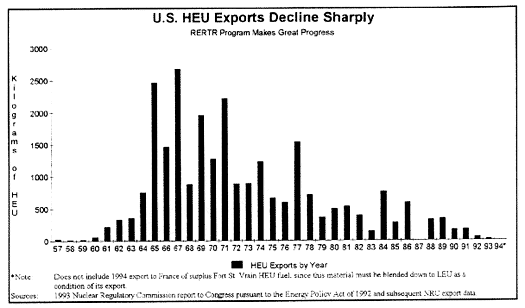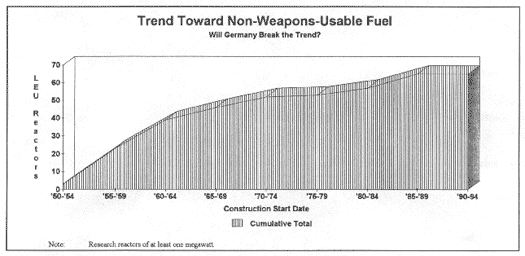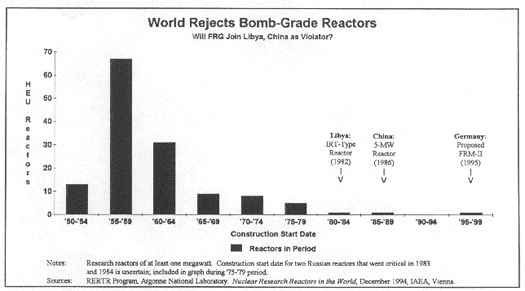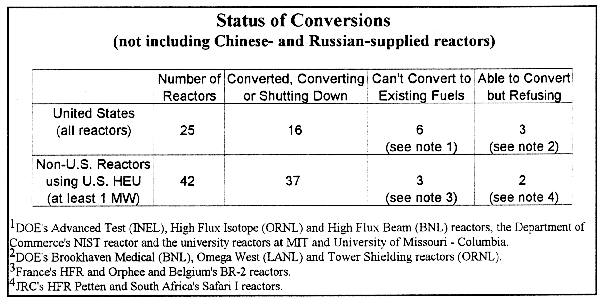Statement of Paul Leventhal
President, Nuclear Control Institute
presented to Hearing of
Fraktion Bundnis 90/Die Grunen
on the
Research Reactor Garching 2 (FRM-1I)
Bonn, Federal Republic of Germany
November 1, 1995
GERMANY'S HEU DECISION AT GARCHING:
IMPACT ON WORLD COMMERCE IN BOMB-GRADE URANIUM1
Thank you for the opportunity to testify on the FRM-II reactor,
which is proposed
to be built at the Technical University-Munich in Garching. The
reactor's current design
would require use of bomb-grade, highly enriched uranium (HEU)
fuel. Proceeding with
this design would have serious negative consequences, not only
for worldwide efforts to
prevent nuclear proliferation,2 but also for Germany's international
standing and
reputation.
It was not very long ago that Germany was viewed internationally
as perhaps the
number-one contributor to nuclear proliferation. In the 1970s
and 1980s German
companies exported heavy-water to India, Israel and Argentina,
low-enriched uranium to
South Africa, warhead "reflector material" to India,
and uranium and tritium processing
technology together with tritium and tritium production technology
to Pakistan. Germany
helped to foster the nuclear weapons programs of these nations
that refused to sign the
Nuclear Non-Proliferation Treaty (NPT), as well as the secret
bomb-grade uranium
enrichment program in Iraq.3 Bundestag investigations in 1988-9
exposed wrongdoing
and led to significant improvements in German export-control laws
and their enforcement,
which have begun to restore Germany's tarnished reputation. Germany's
decision in 1990
to require full-scope safeguards as a condition of nuclear supply
(and thereby ban further
exports to nations outside the NPT) brought Germany in line with
long-standing U. S.
policy and helped strengthen the controls of the Nuclear Suppliers
Group.
However, the pending decision to use bomb-grade fuel in the FRM-II
- contrary
to nearly two decades of international nonproliferation norms
and practice - raises the
risk that Germany once again will be perceived around the world
as contributing to the
global spread of nuclear weapons. The recent disclosure that in
1990 Iraq diverted bomb-
grade uranium fuel from safeguarded research reactors for a crash
program to build
nuclear-weapon components makes clear just how dangerous "civilian"
HEU can be. The
"demonstration effect" of a German decision to use HEU
at Garching could have a
profound proliferation impact on the rest of the world.
Background
In the late 1970s the international community belatedly came to
the realization that
the fuel used in many nuclear research reactors - bomb-grade,
highly enriched uranium -
could be stolen or diverted for nuclear weapons by nations or
terrorists. In 1978, the
international community established the Reduced Enrichment for
Research and Test
Reactors (RERTR) program. Its mission was to develop substitute
fuel of higher-density,
low enriched uranium (LEU), which is not suitable for weapons.
As the substitute fuels
were developed, existing reactors would be converted to LEU and
new reactors would be
designed to use LEU. The RERTR program has proved remarkably successful,
facilitating
the conversion of dozens of reactors worldwide from bomb-grade
to non-weapons-usable
fuel and sharply reducing international commerce in HEU.
Some 42 research reactors with power of at least 1 megawatt were
built outside
the United States, originally using HEU fuel supplied by the U.S.
To date, 37 either have
converted to LEU, are in the process of converting or have no
further need for fuel -
which has enabled a sharp decline in U.S. HEU exports. Since the
United States has
historically been the major exporter of HEU for civilian use,
and in recent years the sole
exporter, this translates into a sharp reduction in total international
commerce in bomb-
grade uranium.
In addition, the United States has taken steps to reduce its own
use of highly
enriched uranium. In 1986, the U.S. Nuclear Regulatory Commission
ordered the
conversion of all licensed, domestic research reactors. Of the
19 such reactors, eight have
converted and another eight are in the process.
More recently, the United States has entered into agreements with
Russia and
China to work on conversion of research reactors operating in,
and supplied by, these
countries. The U. S . is also developing a system for production
of molybdenum-99 for
medical isotopes using LEU rather than HEU targets, to further
reduce the need for
civilian commerce in HEU. The fuel and target development work
is led by the U. S.
Argonne National Laboratory.

The key to the RERTR program's success has been two core tenets:
universality
and spent-fuel return.4 Universality has meant three things: 1)
Those reactors that can
convert to existing LEU fuel must do so; 2) For remaining reactors,
advanced fuel will be
developed, to which they must convert when it is successfully
qualified; and 3) No new
reactors will be constructed to use HEU fuel. Reactor operators
have been willing to
convert to non-weapons-usable fuel - and to accept the economic
and performance
penalties of doing so - because the universality principle guaranteed
that they would not
be put at a competitive disadvantage with respect to neutron research,
medical-isotope
production or other reactor activities.
In keeping with this principle, the United States earlier this
year abandoned plans
for a new HEU-fueled research reactor, the Advanced Neutron Source,
despite the pleas
of U. S. neutron researchers. The Clinton Administration stated
at the time that it made
this decision in part because the bomb-grade fuel presented "a
non-proliferation policy
concern."5 The German government is now presented with the
same decision on the fuel
for FRM-II.

The FRM-II Does Not Require HEU
Other witnesses today have testified to the fact that the FRM-II
does not require
HEU, but I would like to underscore several points. First, the
FRM-II can be redesigned
to achieve its desired experimental performance using LEU fuel
that exists today and has
been qualified since 1988 - with a density of 4.8 g/cc - without
additional fuel
development. At the same time, advanced fuel development has been
restarted at
Argonne, contrary to inaccurate German government assertions that
it has not, in response
to Bundestag questioning. In addition, France's CERCA has already
fabricated higher
density LEU (6.0 g/cc) that would not only provide the equivalent
experimental
performance as HEU but the same fuel-cycle duration. This higher
density fuel is
scheduled to be tested in 1997-8 in France's OSIRIS reactor. However,
there is no need
to await such fuel development in order to convert the FRM design
to LEU today.
Conversion to LEU need not entail substantial delays in construction
of the
reactor. The reactor could be redesigned to use already-qualified
LEU fuel within perhaps
a year. Construction could begin on that design, and if even higher
density fuel is later
successfully qualified, as expected, it could be substituted into
the identical core geometry
without delay to extend the fuel cycle and improve its economics.
This is precisely the
path followed by France's OSIRIS reactor, which converted to 4.8
g/cc LEU this year and
plans to test and then convert to still higher density LEU in
the years ahead.
The FRM-II's conversion to LEU would not in any way affect the
"scientific
position" of Germany, since the reactor's experimental performance
would be essentially
the same (or perhaps better, with the higher density fuel) and
no experiment would be
prevented by conversion to LEU. In addition, an LEU-fueled FRM-II
would overall be no
less safe than the current, HEU design. Indeed, it is the proposed
high-density, HEU fuel
that has failed to undergo safety tests, and best fits the Garching
scientists' category of
"technologically unreliable components. " Also, contrary
to the statement of TU-M
scientists that, "We have not yet heard any critics that
have convincingly explained that
they, with vigor, would support a neutron source operated with
LEU," the Nuclear
Control Institute does support the FRM-II if redesigned to use
LEU.
The FRM-II Undermines Non-Proliferation Efforts
If built to use HEU, the FRM-II would undermine international
nonproliferation
efforts in numerous ways:
1. A Ton of HEU Required for the FRM-II - The FRM-II is
projected to require
40 kilograms of HEU annually, amounting to 1.2 metric tons over
its 30-year life. Thus,
the reactor single-handedly would be responsible for the introduction
of dozens of bombs'
worth of HEU into international commerce.
2. Russia Becomes New HEU Supplier - If the FRM-II uses
HEU, the only
possible long-term source of supply is Russia. Traditionally,
the United States supplied
HEU to European reactors, but this was curtailed under the RERTR
program and then
formally halted by the Schumer Amendment to the Energy Policy
Act of 1992. Existing
stocks of previously exported, U. S. -origin HEU within Euratom
are insufficient to supply
European research reactors that continue to require HEU, in addition
to the FRM-II over
its 30-year life. The nuclear trade press has recently reported
negotiations on HEU supply
between Russia's Minatom and Euratom.6 Such a deal would undermine
years of
international efforts to control Russia's vast stocks of bomb-grade
uranium. Once Russia
gets a taste of hard currency from exporting HEU to Germany, it
will surely look for new
customers to sell this bomb-grade "treasure." The best
hope for preventing Russia's
bomb-grade uranium from falling into the wrong hands is for the
West to maintain united
opposition to Russia exporting any HEU except for immediate blend-down
to non-
weapons-usable LEU.
3. Existing Reactors Will Abandon RERTR - Outside of China
and Libya, the
FRM-II would be the first research reactor (with power of at least
1 megawatt) built to
use bomb-grade fuel since establishment of the RERTR program.
If this should happen, it
would undermine the program's core principle of universality and
could well lead to
rejection of the RERTR program by operators of existing reactors.
They would justifiably
ask why they should absorb the expense and inconvenience of converting
their reactors to
LEU when a new reactor - that could be built to use LEU - is instead
being built to use
bomb-grade fuel.
4. New Reactors Will Demand HEU- Once Germany breaks the
taboo against
new reactors using HEU, it will set a precedent and send a message
that modern reactors
require HEU. In the future, other countries will likewise demand
the right to use HEU in
new reactors and will turn to Russia for supply of the fuel. Siemens
is presumably
prepared to supply the reactor abroad. Indeed, press reports indicate
that Siemens views
the FRM-II as a "prototype" for future exports. The
international nonproliferation regime
will be ill-prepared to reject the demands of other countries
for HEU-fueled reactors if
Germany itself uses such fuel in the FRM-II.

5. Risks of Proliferation and Terrorism Will Rise with HEU
Commerce - If the
FRM-II uses HEU, Russia begins to supply it, existing reactors
renew their demand for it,
and new reactors are designed to use it - international commerce
in bomb-grade uranium
will expand rapidly and nearly two decades of progress by the
RERTR program will be
severely undermined. As large volumes of EMU begin to be shipped
again around the
globe, they will inevitably be vulnerable to theft and diversion
by increasingly sophisticated
and violent terrorists and renegade states. Once HEU is obtained,
construction of a
nuclear weapon is relatively straightforward, as Manhattan Project
physicist Luis Alvarez
testified in his memoirs:
With modern weapons-grade uranium, the background neutron rate
is so
low that terrorists, if they had such material, would have a good
chance of
setting off a high-yield explosion simply by dropping one half
of the
material onto the other half. Most people seem unaware that if
separate
HEU is at hand it's a trivial job to set off a nuclear explosion
. . . even a
high school kid could make a bomb in short order.7
Other Threats to the RERTR Program
The FRM-II is one of a number of recent developments that threaten
to undermine
international support for the RERTR program. The other principal
threats to RERTR are:
Reactors Refusing to Convert - Several reactor operators
are violating the
principle of universality by refusing to convert their reactors
even though suitable
LEU fuel is available. Outside of the United States, there are
two: the JRC's HFR
Petten and South Africa's Safari I reactors. In the United States,
there is only one
remaining, the Department of Energy's Brookhaven Medical (BNL)
reactor, since
the Omega West (LANL) and Tower Shielding (ORNL) reactors have
been shut
down. Two other U.S. facilities, the High Flux Beam (BNL) and
NIST reactors,
have preliminarily been determined unable to convert to existing
LEU fuels (see
next item), but further feasibility studies are required for a
final deterrnination.
Proceeding with the current FRM-II design would reinforce the
intransigence of
the operators of these reactors and undercut international leverage
to compel their
conversion.
Advanced Fuel Development - Several other reactors have
not converted because
suitable LEU fuel has not been developed. Outside the U.S., there
are three:
France's HFR and Orphee and Belgium's BR-2 reactors. In the U.S.,
there are six:
the Department of Energy's Advanced Test (INEL), High Flux Isotope
(ORNL)
and High Flux Beam (BNL) reactors, the Department of Commerce's
NIST
reactor and the university reactors at the Massachusetts Institute
of Technology
(MIT) and University of Missouri - Columbia. In 1989, the United
States
suspended development of advanced, high-density (>4.8g/cc)
LEU fuels for such
high-power research reactors - further undermining the principle
of universality.
But the United States Department of State recently supplied $1.5
million to
immediately restart fuel development, with another $2.0 million
expected to be
provided during the next few months by the Department of Energy,
but the
primary focus appears to be for Chinese and Russian reactors.
It is essential that
the United States clarify that such development will include fuels
for the remaining,
unconvertible reactors in the U. S. and Europe, which is estimated
to require
approximately five years.
Spent Fuel Take-Back - In 1986, the United States suspended
the take-back of
U. S.-origin spent fuel from research reactors, despite long-standing
commitments
to take back this fuel. If the policy is not fully renewed in
an expeditious manner,
reactor operators will be forced to pay higher costs for reprocessing
of their spent
fuel in Europe, removing an incentive for cooperation with the
RERTR program.
Such reprocessing will also likely perpetuate the HEU fuel cycle.
Moreover, some
operators may actually be forced to continue using HEU fuel since
there is no
reprocessing line in Europe for LEU research reactor fuel. However,
this problem
may soon be resolved because the United States is expected to
issue a final
environmental impact statement and record of decision to renew
the take-back
program by the end of 1995. At that point, the FRM-II would remain
as perhaps
the primary obstacle to fulfillment of the RERTR program's mission.

Conclusion
The RERTR program is one of the unsung heroes of the International
Atomic
Energy Agency and Nuclear Non-Proliferation Treaty regimes. Since
1978, the program
has made great progress in reducing HEU commerce. If the international
community
provides its full support, the RERTR program can within the decade
fulfill its goal of
eliminating entirely commerce in bomb-grade uranium. However,
if such leading nuclear
industrial states as Germany and the United States continue the
recent trend of
withholding their full cooperation from the program, it could
soon collapse, resulting in a
resurgence of HEU commerce.
The RERTR program is at a historic crossroads. Only its participating
members
can determine which path it will follow. Germany's decision on
the FRM-II is an essential
element in determining whether the RERTR program fulfills its
mission to eliminate HEU
commerce, or whether there is a rapid expansion in international
HEU commerce that
significantly increases global risks of nuclear proliferation
and nuclear terrorism.
NCI
END NOTES
l. Alan Kuperman, Senior Policy Analyst for NCI, participated
in the preparation of this paper.
2. Also, see Paul Leventhal, "Testimony in Opposition to
the Proposed FRM-II Nuclear Research Reactor," presented
to the Bavaria Ministry for Development and Environment, May 10,
1994.
3. See, for example, Paul L. Leventhal, "Plugging the Leaks
in Nuclear Export Controls: Why Bother?" Orbis (Spring
1992), pp. 169-170; Gary Milhollin, "Bonn's Proliferation
Policy," The New York Times, January 4, 19S9; Gary
Milhollin, "Asia's Nuclear Nightmare: The German Connection,"
The Washington Post, June 10, 1990.
4. The guarantee of spent fuel return (for both LEU and HEU fuel)
is based on four grounds: I ) Reducing the vulnerability of spent
HEU fuel to theft or diversion; 2) Abiding by long-standing U.S.
commitments; 3) Inducing cooperation with the RERTR program; and
4) Avoiding an additional, perverse penalty for conversion to
LEU-i.e. losing the guarantee of spent fuel return.
5. "DOE Facts: A New Neutron Source for the Nation,"
U.S. Department of Energy, February 1995, p. 1.
6. Mark Hibbs, "Minatom, EC to Discuss Sale of HEU for Research
Reactors," NuclearFuel, September 25, 1995, p. 7.
7. Luis Alvarez, Adventures of a Physicist (Basic Books,
1987), p. 125.
![[Home Page]](../2img/gohome.gif) NCI Home Page
NCI Home Page
mail@nci.org



